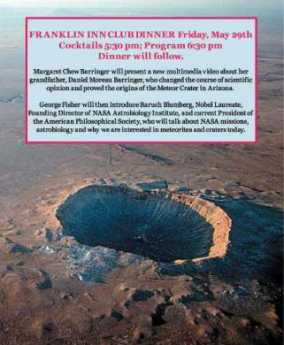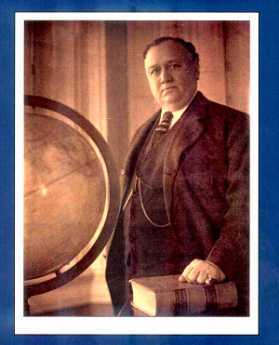Related Topics
Franklin Inn Club
Hidden in a back alley near the theaters, this little club is the center of the City's literary circle. It enjoys outstanding food in surroundings which suggest Samuel Johnson's club in London.
Historical Preservation
The 20% federal tax credit for historic preservation is said to have been the special pet of Senator Lugar of Indiana. Much of the recent transformation of Philadelphia's downtown is attributed to this incentive.
Science
Science
Barringer Crater in Winslow AZ

|
| Barringer Crater |
There are several big holes in the ground, clustered fairly close together in the high plains of northern Arizona. One of them is an extinct volcano, one is a sink-hole where the ground collapsed over an empty aquifer, one is the Grand Canyon. And one of them is the Barringer meteorite crater, about a mile wide and half a mile deep. In the summer, environmental temperatures above 105 degrees are fairly common, and as I have reason to know, the crater can be covered with two feet of snow in February. It's near the town of Winslow, and was called the Winslow crater in a popular song, Take it Easy by The Eagles of ten or more years ago, as well as being featured for the last fifteen minutes of a movie called Starman that is still reasonably exciting to watch.

|
| Daniel Moreau Barringer (1860-1929) |
As recently explained by Margot Barringer at a dinner at the Franklin Inn Club last week, the crater was explored, and purchased, by her grandfather, Daniel Moreau Barringer (1860-1929), who had made a fortune in mining discoveries and could afford to buy a big hole in the ground. Daniel Barringer was a Princeton classmate and friend of Woodrow Wilson and Cyrus McCormick, as well as a friend of Theodore Roosevelt. Barringer's young son owned a .22 rifle and amused himself shooting at mud puddles. One day, he exclaimed that the shapes of the bullet holes in the ground were exactly like the shape of the Arizona hole; they all had a circular opening no matter what direction the bullet came from. From that came the idea that the crater was not an extinct volcano as many local natives believed, but the crater of a meteor, since the mouth of the crater would remain roughly circular regardless of the direction of the impact. That shape helps explain the confusion with the mouth of a volcano. While generally accepted today, meteor craters were a comparatively recent idea at that time. Geologists like to argue a lot -- Barringer himself was particularly vocal-- and it took quite a few years before the meteor theory of this particular crater was generally accepted. Poor Barringer became obsessed with the idea that commercial deposits of iron ore could be found if you dug deeply in or around the crater, but it wasn't true, and he essentially lost his fortune trying to dig 28 deep holes there. Sadly, he died of a heart attack very shortly after the scientific world finally agreed with his Theory of the crater's formation. The decline in the family fortune may also have been related to the significant year -- 1929 -- of his death. Two other granddaughters have written an interesting book about this personal and geological struggle.

|
| Baruch Blumberg |
At the Franklin Inn dinner, Baruch Blumberg (who had won a Nobel Prize for the discovery of the hepatitis B virus and its vaccine) then offered a fascinating discussion of meteors and craters. He's President of theAmerican Philosophical Society, but his credentials for this topic come from his second career as Director of the Astrobiology Institute of NASA. He tells us it might be better to call it an asteroid crater since most meteors are circulating asteroids that lose their way and come crashing through our atmosphere. There are quite a few asteroids floating around reasonably close nearby, and more big ones can be expected to drop in on us about once every two thousand years in the future. NASA seems to have given a lot of thought to this topic, including a theory that the moon was once a piece of the earth which got knocked loose by a big asteroid hitting us at some distant time in the past. There's a big crater in Siberia, and it is thought that dinosaurs were exterminated by a huge asteroid hitting the Yucatan. When you look at the surface of the moon, you see that lots and lots of asteroids have been flying about, but most of the evidence has been eroded away.
If there is a serious danger of another big one hitting us, and smart people can calculate its future path, what can we do about it? Well, the people at NASA have given that some serious thought. Attaching an outboard motor to the asteroid doesn't sound very workable, but painting one side of it white might be because white will reflect light and heat and push the asteroid in some different direction. And shooting big bombs at it to change its course might be practical. Right now, all of the asteroids seem to be headed in harmless directions, but it pays to be prepared.
The idea that iron and nickel could be found in the crater comes from knowing, Lord knows how that the center of the earth is molten iron. That creates the theory that asteroids might be mostly made of iron, burying commercial amounts of it underground when they hit. Unfortunately, the size calculations are all wrong, and Barringer's son had it about right that a .22 bullet would kick up a much larger hole than itself. Anyway, some consolation lies in 250,000 paying visitors to the crater every year, and an occasional movie or NASA experiment paying for temporary use. The downside of economics is that Barringer had eight children, and lots of them had lots of children. Fecundity seems to be a characteristic of most Barringers; one member of the clan estimated at least a thousand living relatives at one remove or another, all of them presumably willing to share in the gate receipts if some learned counsel advises an aggressive approach.
So, since it more or less belongs to Philadelphia, more visits to this crater are recommended. Except, perhaps, in February. April, when the desert is in bloom, might be more enjoyable.
REFERENCES
| A Grand Obsession: Daniel Moreau Barringer and His Crater: Nancy Southgate: ASIN: B0006SAYHU | Amazon |
Originally published: Sunday, May 31, 2009; most-recently modified: Tuesday, May 14, 2019